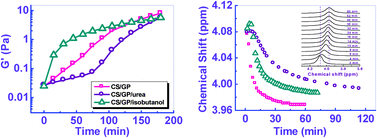Synergistic interactions during thermosensitive chitosan-β-glycerophosphate hydrogel formation
Abstract
Time-evolved

* Corresponding authors
a
Key Laboratory of Molecular Engineering of Polymers of Ministry of Education, Department of Macromolecular Science, Laboratory of Advanced Materials, Fudan University, 220 Handan Road, Shanghai, China
E-mail:
chenx@fudan.edu.cn
b
Research Center for Analysis and Measurement, Fudan University, 220 Handan Road, Shanghai, China
E-mail:
yuhongyang@fudan.edu.cn
c Department of Chemistry, Fudan University, 220 Handan Road, Shanghai, China
Time-evolved

 Please wait while we load your content...
Something went wrong. Try again?
Please wait while we load your content...
Something went wrong. Try again?
X. Qiu, Y. Yang, L. Wang, S. Lu, Z. Shao and X. Chen, RSC Adv., 2011, 1, 282 DOI: 10.1039/C1RA00149C
To request permission to reproduce material from this article, please go to the Copyright Clearance Center request page.
If you are an author contributing to an RSC publication, you do not need to request permission provided correct acknowledgement is given.
If you are the author of this article, you do not need to request permission to reproduce figures and diagrams provided correct acknowledgement is given. If you want to reproduce the whole article in a third-party publication (excluding your thesis/dissertation for which permission is not required) please go to the Copyright Clearance Center request page.
Read more about how to correctly acknowledge RSC content.
 Fetching data from CrossRef.
Fetching data from CrossRef.
This may take some time to load.
Loading related content
